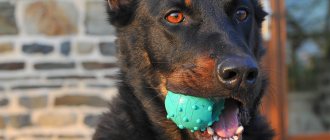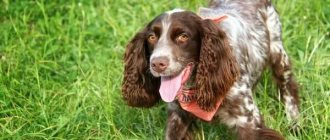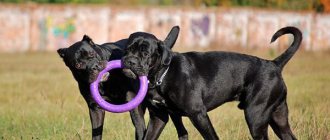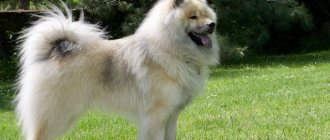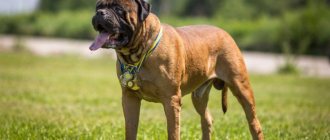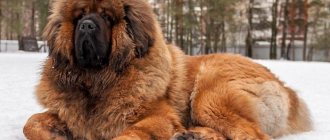Schipperke's historical roots
The closest ancestors of the universal dog are represented by Belgian Shepherds and Leuvenards - black dogs of the 15th century, bred in Belgium in the Brabant region. The individuals became famous in the fight against hordes of rats when the Senna River flooded.
- They earned the respect not only of townspeople and merchants, protecting their homes and livestock, but also of sailors, guarding boat stations and barges.
- In 1882, Princess Henrietta got a charming little black one, and the local nobility followed her example.
- After the formation of the breeding club, the Schipperke breed acquired the canons of an external standard; exhibitions contributed to its popularity in America and Europe.
Breeding in Russia began not so long ago, the majority of Russian representatives are of American origin, they are more massive compared to the European stock, the skeleton of which is lighter, and the muzzle looks friendlier.
Description of the Schipperke breed
Due to the characteristic “jabot” and “panties” in the area of the developed neck and hips, there is a similarity with the Spitz.
Recognizable features:
- The head has a wedge-shaped appearance, prominent cheekbones flow into a neat nose, which is crowned with a coal-black lobe.
- The lips have a uniform dark color.
- The strong teeth meet in a scissor bite.
- Almond-shaped eyes with dark brown irises have an attentive, lively gaze.
- The stocky body, proportional build, confidently rests on stable, muscular legs.
- The high-set, triangle-shaped ears are mobile, giving the Belgian an alert appearance.
- The chest is lowered with a smooth line of the bottom, turning into a tucked stomach.
In movement, a springy, regular trot is clearly visible. Schipperke puppies may have no tail at birth, which is not considered a defect. If a full-fledged tail is present, then it does not curl, laying on the lower back, it simply hangs down. Previously, this part was cropped, which is prohibited today.
The main wealth of the mini-shepherd is its delightful straight and thick charcoal coat with a rigid axis; the undercoat may have a gray color that is not visible under the “fur coat”. The weight of the shaggy friend varies between 3-9 kg, the height at the withers does not exceed 35 cm.
Character traits
A touching appearance, coupled with a compact physique, coexists with an independent streak. The pet needs early socialization, meeting new people and “Kindreds”.
An energetic, cheerful, curious dog will not decorate the sofa; he must be provided with an active lifestyle and sports activities. The kilometers you log will only do you good. Static homebodies who are often away are not suitable for the role of hosts.
Photos of the Schipperke prove that this is a true bundle of energy that requires two walks a day, jogging behind the bike, following the owner’s commands, and entering into emotional contact with him.
- The pet is infinitely devoted to members of the household and distrustful of strangers, loves children, and has a hard time withstanding loneliness.
- Gentleness and inconsistency in upbringing guarantee the transfer of leadership into his “paws,” which will later be too late to correct.
- The puppy is not allowed outside until it is vaccinated. The fidgets are preparing an enclosure-house, otherwise the destroyer will turn everything upside down during the period of absence of the pets.
They walk around the city only with a leash fastened; a quick reaction will push the “little one” to do unexpected things. The “alarm bell” has phenomenal hearing, so the appearance of a butterfly in the room or any rustle outside the door will be barked at or greeted with a dissatisfied grumble.
At what age do you start training?
Puppy training must begin from the very first days
the presence of a dog in your home. Because already from infancy, the puppy must learn the rules of behavior in your house, what is allowed and what is forbidden, how to behave with all family members, even the smallest and oldest, what he can play with and what he can’t, where to go. toilet and much more.
And we are talking, first of all, about the proper upbringing of a Schipperke puppy, and you can start training and learning commands when the puppy is completely comfortable in your home. As a rule, one week is enough. By this time, the puppy is already filled with curiosity and is diligently exploring the world around him. If, after this time, the puppy remains fearful and does not make contact well, then it is better to seek help from a dog handler-animal psychologist, because This behavior is not typical for puppies of this breed.
When can you start training with a dog handler?
The beginning of the puppy's training coincides with the time of the first exit to the street. When the first two vaccinations have already been done, the quarantine (lasts 7-14 days, depending on the vaccination) after them is over. It is not at all necessary to train your puppy only outside; the first sessions are best done at home, where there are fewer distractions.
Often new puppy owners worry that training from the first days will be excessively stressful for the dog. This is only possible if outdated, rigid methods are used, and with the right approach, training from the first days will, on the contrary, be very useful, since it allows you to immediately establish contact
with the puppy and build a trusting relationship.
You can start raising a puppy from the first days of its appearance in your home, and training and classes with a dog handler can begin simultaneously with the start of walks, when quarantine ends after the second vaccination.
Why you don't need to wait up to 6 months
You often hear that the Schipperke, like other dogs, cannot be trained before 6 months, because training is stressful. This opinion remains from the times of outdated methods based on cruel coercion and intimidation of the dog. Unfortunately, there are still plenty of dog handlers using similar techniques today. But fortunately, science does not stand still and modern techniques make it possible to train a puppy from the first days in a new home. Therefore, you should not wait until your Schipperke puppy has established unwanted behavior; you can start training much earlier.
How to train the Schipperke breed
A smart and inquisitive Schipperke dog is trained at the age of two months. It is advisable to start with five-minute lessons, since the restless creature is not capable of long-term concentration.
Natural suspicion interferes with concentration; the dog is distracted by any sound or smell, rushing to look for its source. Children should not be trained; the animal will not feel their superiority, which means submission is impossible.
- The ward must constantly pay attention, otherwise he will find his own fulfillment, rummaging through closets, taking away packages, “rescuing” bathers from the bath.
- He works for a treat that coaxes, stimulates and calms.
It is not difficult to establish a connection with a four-legged friend if you do not forgive him for pranks, educate him in the process of play and treat him as a valuable comrade, insisting on his own and maintaining calm confidence. Better yet, use the services of a professional dog handler.
Diseases inherent in the breed
In general, Schipperkes are the owners of good health. Their lifespan is 13–15 years. But hereditary diseases have not spared this breed at all. Basically, veterinarians note the genetic predisposition of these dogs to the following pathologies:
- Epilepsy. This is a chronic disease of the nervous system that manifests itself in seizures. During them, the dog may lose consciousness. The disease is not completely curable, but can be corrected with medication, so the pet has every chance of living a long and happy life.
- Cataracts and retinal atrophy. Cataract is a clouding of the lens, which results in decreased visual acuity up to complete blindness. Retinal atrophy is the death of light-sensitive receptors. Treatment is medicinal, and the earlier it is started, the more effective it is.
- Hypothyroidism - insufficient production of thyroid hormones. It manifests itself as weakness, lethargy, and rapid fatigue of the pet. Possible dullness and hair loss. Treatment is carried out by introducing the missing hormones.
- Hip dysplasia. Incorrect development of the hip joint, in which abrasion of cartilage and then bone tissue occurs, can manifest itself at first as a slight lameness, and lead to disability. Treatment can be either medicinal or surgical; it is important to start it in a timely manner.
- Perthes syndrome. The pathology consists in the death of the tissues of the hip joint, which leads to its destruction. It manifests itself as lameness, the dog’s desire to protect the paw with the affected joint. Drug therapy is effective only in the initial stages of the disease, then surgery cannot be avoided.
- Mucopolysaccharidosis is a metabolic disorder. It may manifest itself as clouding of the eyes, enlargement of the tongue, and deformation of the skeletal system. It is treated with a bone marrow transplant or enzyme medications, but both types of therapy are expensive and not widely used.
Grooming activities
By historical standards, this is not a decorative type; the Schipperke Shepherd Dog has not previously spent the night in housing, it ate what was given, carrying out security activities. Today's purebred descendants do not require specific care, they are not afraid of the cold, and live not only in apartment conditions, but also in a booth or enclosure. For a clean creature, a little care is enough.
Due to the thick, dense wool, which has water-repellent properties, it is not afraid of getting wet; drying occurs naturally.
- The disadvantage is shedding, at which point it will require daily brushing instead of a regular couple of times a week.
- Bathing is done as needed, using a minimum of shampoo, maintaining a lubricating fat layer.
- The ears are cleaned with disinfectants, the eyes are washed with chamomile infusion, preventing them from souring.
- The dentition is cleaned with veterinary paste applied to the brush.
It will be necessary to trim the nails monthly without damaging the blood vessels. In the winter season, nourishing cream is rubbed into the paw pads in connection with the treatment of roads with reagents.
Application
The skills developed by the breeders allow the Schipperke to be used as a guard and hunter.
In urban environments, the breed acts as a pleasant and loving companion.
The dog is especially suitable for those who are lonely and cannot afford to keep a large watchman.
With a Schipperke you will have a fearless defender who can scare away enemies.
The animal also behaves well in a large family, quickly becoming a friend to all its members.
You can read about other dogs that are suitable as a companion here:
Schipperke baby
Feeding
The type of food is chosen by the owners. High-quality dry food contains balanced vitamins and minerals. The advantage of natural food is that it suits the digestion of any individual, but cooking takes time, and the addition of mineral complexes is also necessary.
The menu is updated:
- Lean meat.
- Fish fillet.
- By-products.
- Porridge.
- Vegetable supplements.
Milk porridge is prepared for the little ones, and boiling water is poured over the cereal for adults. Feed with boiled eggs and raw yolks, fermented milk products. Babies are fed more often, and from the age of nine months they are transferred to morning and evening feeding.
Dog food
The diet of these dogs is no different from other breeds. The main rule for dog owners is not to overfeed their pets .
The menu is approximately as follows:
- Fortified dry food.
- A variety of dairy products, among which low-fat cottage cheese must be present.
- Boiled root vegetables.
- Boiled beef.
- At least three types of cereals.
- Hard-boiled eggs.
- Fish.
- In some cases, you can add greens.
What is contraindicated for dogs are long bones. They are capable of inflicting such wounds on a dog’s stomach that the animal even dies.
Accompanying illnesses
Cheerful animals usually do not have health problems; they happily live up to 15 years.
Visits to the clinic are possible due to:
- Hypothyroidism;
- Allergies;
- Patella dislocation;
- Perthes disease.
The breed is characterized by one significant unpleasant disease - mucopolysaccharidosis, which, unfortunately, cannot be cured. It appears from the age of 2, the reason lies in a genetic mutation that is inherited.
The price of a Schipperke ranges from 30-70 thousand rubles; in order not to buy a sick baby, it needs to be tested. Teenagers and cubs that do not meet the exterior requirements will cost less.
Choosing a puppy
Although Schipperkes are quite popular in Europe, this breed is still rare in Russia. The dogs are bred in the same kennel "Schipperke"
, which is located in the Moscow region. But it is possible that there are also private individuals involved in breeding dogs of this breed.
In order not to make a mistake in your choice, you need to check the documents for the baby you are purchasing. He must have a pedigree or a puppy card, on the basis of which a pedigree is drawn up in the club. Try to see the puppy’s parents and evaluate their behavior.
A Schipperke puppy is expensive, so you need to make sure it has a pedigree
The small number of this breed affects the cost of puppies. Thus, a pet-class baby (not suitable for exhibitions and breeding) can be purchased from 30,000 rubles. A breed-class puppy will cost 40–60,000 rubles, and for a show-class baby you will have to pay from 70,000 rubles.


